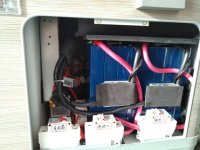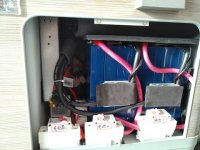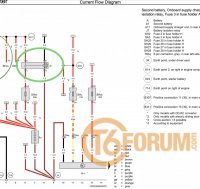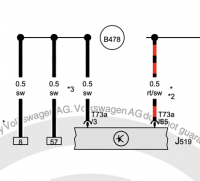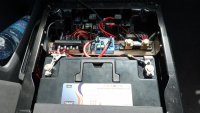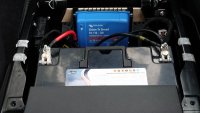- Home
- Forums
- VW California T5 T6 & T6.1 Specific Sections
- VW California T5,T6 & T6.1 Specific Sections
- Electrical
You are using an out of date browser. It may not display this or other websites correctly.
You should upgrade or use an alternative browser.
You should upgrade or use an alternative browser.
How-To install DC-DC charger to replace VW Split Charge relay
- Thread starter Loz
- Start date
-
- Tags
- redarc split charge vsr
Sp0_0k
- Messages
- 1,247
- Vehicle
- T6 Beach 4Motion
Cables alone, sexy. 
M
marchugo
- Messages
- 500
Hi Loz,
In your excellent description how to install a dc-2-dc charger, I found an image of the D+ control plug in the VW seperation relay under the driver seat.
Do you by chance remember how to detach and split the D+ cable in that plug (the brown one I presume)?
Reason: I plan to install a separated third leisure battery (LifePo4) for our e-bikes, under the passenger seat, and would like to feed this bat with a B2B booster (maybe a Votronic 1212/30). It would be nice to connect the D+ wire to this booster, as this assures a small back stream of loading for the starter battery.
I prefer not to split this D+ wire with a 'current thief', as this is unsecure, and also could cause unwanted resistance in the wire connection to the alternator.
All the best from Amsterdam,
Marc.
BTW, in my control plug I only have the two D+ wires (brown and black, see picture). In yours I also see a red plus cable. Where does that come from and what was its function in your former setup?
My plug:
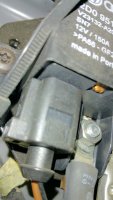
Your plug:
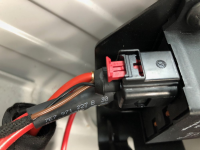
In your excellent description how to install a dc-2-dc charger, I found an image of the D+ control plug in the VW seperation relay under the driver seat.
Do you by chance remember how to detach and split the D+ cable in that plug (the brown one I presume)?
Reason: I plan to install a separated third leisure battery (LifePo4) for our e-bikes, under the passenger seat, and would like to feed this bat with a B2B booster (maybe a Votronic 1212/30). It would be nice to connect the D+ wire to this booster, as this assures a small back stream of loading for the starter battery.
I prefer not to split this D+ wire with a 'current thief', as this is unsecure, and also could cause unwanted resistance in the wire connection to the alternator.
All the best from Amsterdam,
Marc.
BTW, in my control plug I only have the two D+ wires (brown and black, see picture). In yours I also see a red plus cable. Where does that come from and what was its function in your former setup?
My plug:

Your plug:

Loz
Super Poster
Lifetime VIP Member
Hi Marc
the black wire is the D+ the brown Is neutral. The Red wire is an optical illusion, it it the wire behind the plug on the relay side supply side.
You can release the cable by sliding the coloured insert over.
the black wire is the D+ the brown Is neutral. The Red wire is an optical illusion, it it the wire behind the plug on the relay side supply side.
You can release the cable by sliding the coloured insert over.
M
marchugo
- Messages
- 500
Thanks Loz. Of course your answer was clearly documented a few pages earlier... My actual question is: how can I get the brown and the black strands out of that plug without destroying these small cables. It seems to me that they are too tightly connected into the plug to get them out without force.
Marc.
Marc.
Loz
Super Poster
Lifetime VIP Member
Some VW plugs have a slide that releases the pins, for others you need a 2 prong tool like this;
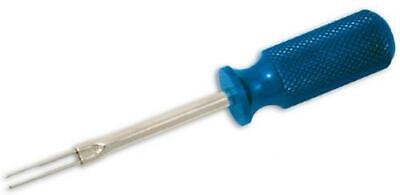

Laser 3932 Terminal Tool Volkswagen Audi | eBay
Find many great new & used options and get the best deals for Laser 3932 Terminal Tool Volkswagen Audi at the best online prices at eBay! Free delivery for many products!
www.ebay.co.uk
rod_vw
Gone bigger.
Top Poster
VIP Member
M
marchugo
- Messages
- 500
Hi Marc
the black wire is the D+ the brown Is neutral.
Hi Loz,
If the black wire is the D+, what function does the neutral brown one have? (they both go into the VW relay).
Can I ignore the neutral wire, and only split the black plus to give my Votronic B2B 1212-30 the signal of the running alternator?
(BTW: in the electrical layouts of the Cali I always see the D+ as a brown wire).
Marc.
Loz
Super Poster
Lifetime VIP Member
M
marchugo
- Messages
- 500
Thanks for the info and the diagram. Loz.
I can now see that the black plus signal wire is coming from connection nr. 46. Not sure if that's the same in my T5.1 (2009), but I think maybe it is coming from the D+ connector 73 A /3 under the light switch.
Regards from Amsterdam,
Marc.
I can now see that the black plus signal wire is coming from connection nr. 46. Not sure if that's the same in my T5.1 (2009), but I think maybe it is coming from the D+ connector 73 A /3 under the light switch.
Regards from Amsterdam,
Marc.
Loz
Super Poster
Lifetime VIP Member
BenPcaliman
Great post so thanks for that.
now i did find last year in europe the leisure bats were not charging properly after a bit of a drive which was quite frustrating but out solar panel did a ok job of keeping them topped up unless it was cloudy or shady.
question is is it worth the money spent. Would be nice i know that when arriving at a site we know the batts at fully charged.
would this kit be suitable for a bluemotion 2014 t5 cali? Can't see it being any different to the t6
now i did find last year in europe the leisure bats were not charging properly after a bit of a drive which was quite frustrating but out solar panel did a ok job of keeping them topped up unless it was cloudy or shady.
question is is it worth the money spent. Would be nice i know that when arriving at a site we know the batts at fully charged.
would this kit be suitable for a bluemotion 2014 t5 cali? Can't see it being any different to the t6
Last edited:
NRDSRFR
Looking to put solar on our Beach due to arrive next month. I would like:
1. MPPT tracker (ideally max voltage to work with 2x120W panels in series)
2. Charge leisure battery to 100% from solar and engine and keep it maintained.
3. Keep engine battery maintained (trickle)
4. Don't discharge the leisure battery to 80% as soon as the engine is started.
5. Nice to have:- Load shed once leisure battery becomes discharged to prevent damage.
6. Meter or App to show current, Amp hours, and voltage.
And ideally in one small box that fits in the space where the split charge relay is under the seat. Also conscious that this will be a brand new Beach, so a bit wary of messing with it too much and affecting the warranty!
I've seen 5 devices in this space at reasonable price (<£300 or so), but none do everything I want. Ablemail looks like it is nearly there, but doesn't maintain the starter battery.
I suspect 2 boxes will achieve all this, but not sure which combination would be best. Any suggestions much appreciated.
Cheers.
Requirement Victron SmartSolar Votronic MPP 250 Duo CTEK D250SE Redarc BCDC Ablemail AMS12-12-30 1. MPPT tracker (ideally max voltage to work with 2x120W panels in series)
Y Y N (Max voltage 23V) Y Y 2. Charge leisure battery to 100% from solar and engine and keep it maintained. Y Y Y Y Y 3. Keep engine battery maintained. N Y Y N N 4. Don't discharge the leisure battery to 80% as soon as the engine is started. N N Y Y Y 5. Nice to have:- Load shed once leisure battery becomes discharged to prevent damage. Y N N N N 6. Display or App to show current, Amp hours, and voltage. Y Y N (I think) N Y (maybe) Nice to have:- Ability to have a different type of leisure battery from the starter battery N N Y Y Y
I'm not sure this information is correct. I just installed a Votronic dual MPPT (the 165W version since I'm only using a single panel) and it has comprehensive options for the leisure battery type selection including multiple voltages per type, with a separate lead for the starter (lead).

I'm also not sure what you mean by
??Don't discharge the leisure battery to 80% as soon as the engine is started.
Are you saying you think starting the engine will draw from the leisure batteries? Because the controller is only connected to the starter by a thin 5A cable and charges from 0 - 1.0A according to the manual. It doesn't otherwise change how the relay connects the two, so I can't see how this is possible.
Nice to have:- Load shed once leisure battery becomes discharged to prevent damage.
I'm no expert on what Load Shedding is, but the 1st page of the manual I attached has a lot of details regarding Votronic features which seem fairly comprehensive in terms of power management.
Maybe someone can clarify if it has an equivalent feature which is described differently. I'm interested for my own sake since I have it installed as of this week!
Attachments
A
a892374923874
VIP Member
The Votronic is just a solar charger. It works *in addition* to the charge received from the alternator which is designed for the original battery. So even if you installed a LiFePO4 battery and set the Votronic to LiFePO4, the alternator would try and charge as per the original battery while driving. This would not end well.I'm not sure this information is correct. I just installed a Votronic dual MPPT (the 165W version since I'm only using a single panel) and it has comprehensive options for the leisure battery type selection including multiple voltages per type, with a separate lead for the starter (lead).
View attachment 63331
To use a LiFePO4 leisure battery you'd need a separate (DC to DC) charger which would replace the simple VW relay. Then you could set the Votronic to LiFePO4 as well.
No, The leisure battery would not be used during the actual start, because the VW relay that connects the leisure battery to the engine battery to charge it up only kicks in *after* engine start. Once it does kick in though, if the Leisure battery has been charged to 100% by the Votronic, then it will be discharged down to 80% because it is directly connected to the engine battery via that relay. The engine battery is only charged to a max of 80% on the T6 due to Bluemotion.Are you saying you think starting the engine will draw from the leisure batteries? Because the controller is only connected to the starter by a thin 5A cable and charges from 0 - 1.0A according to the manual. It doesn't otherwise change how the relay connects the two, so I can't see how this is possible.
The way to avoid this leisure battery discharge is to replace the VW relay with a DC to DC charger on a T6.
Load shedding is where the load (eg. lights, fridge etc) can be automatically switched off when the leisure battery voltage gets too low. As standard the 12V sockets and lights are directly connected to the leisure battery, so there is nothing stopping you leaving everything on and running the battery down and destroying it. If you use the Victron, you can rewire the 12V sockets etc so they go via the load shed relay in the Victron, which will then switch them off at low voltage, thus protecting the battery.I'm no expert on what Load Shedding is, but the 1st page of the manual I attached has a lot of details regarding Votronic features which seem fairly comprehensive in terms of power management.
Maybe someone can clarify if it has an equivalent feature which is described differently. I'm interested for my own sake since I have it installed as of this week!
The Votronic didn't have this from what I could work out. Although it does mention an AES output to control a fridge.
So to summarise, the holy grail needs a DC to DC charger which will charge the leisure battery properly to 100% while driving. Then a Solar charger that can also trickle charge the engine battery without upsetting the DC to DC charger, and shut off the 12V sockets when the battery gets too low. There's also the built in charger to consider which charges both engine and leisure batteries when you plug in the EHU cable.
I couldn't find a solution that did everything I wanted so I gave up looking after I wrote the post last year. Since then some new stuff has come out from Victron and I think Votronic, but I havent yet investigated.
Last edited:
A
a892374923874
VIP Member
Ah, I've just seen you have a T5 which I think doesn't have all the Bluemotion stuff. So for you, the discharge to 80% problem does not exist. Your leisure and engine batteries will always be charged to 100% so no need for a separate DC to DC charger. The Votronic is fine as a solar controller.
I'm sure someone else will chime in if I've got that wrong!
I'm sure someone else will chime in if I've got that wrong!
Sp0_0k
- Messages
- 1,247
- Vehicle
- T6 Beach 4Motion
I haven't noticed leisure battery discharge when driving. I installed a monitor on existing battery setup to analyze all current flows.
If you are driving after hookup the leisure battery stays well topped up at 14,8volts with trickle amps going in.
At least on mine T6 beach.
I am testing my Lifepo4 battery setup for 2 years and I gave up the initially planned solar panels upgrade. And we are cooking and boiling everything on electricity.
Instead go for a decent beefy lifepo4.
New prismatic 280Ah x4 cells will weigh around 20kilos and cost around 650 usd from china.
Thats 3,6 kilowatt hours that can run you for week with no sunny weather.
Building the battery isn't that hard. A bms with mobile monitoring via bluetooth is another 70usd.
With bms you can just wire a cheap buck converter that limits voltage and current for DC-DC charging.
Wire that all on current leisure battery under the seat and throw away second leisure battery if you have it.
If you are driving after hookup the leisure battery stays well topped up at 14,8volts with trickle amps going in.
At least on mine T6 beach.
I am testing my Lifepo4 battery setup for 2 years and I gave up the initially planned solar panels upgrade. And we are cooking and boiling everything on electricity.
Instead go for a decent beefy lifepo4.
New prismatic 280Ah x4 cells will weigh around 20kilos and cost around 650 usd from china.
Thats 3,6 kilowatt hours that can run you for week with no sunny weather.
Building the battery isn't that hard. A bms with mobile monitoring via bluetooth is another 70usd.
With bms you can just wire a cheap buck converter that limits voltage and current for DC-DC charging.
Wire that all on current leisure battery under the seat and throw away second leisure battery if you have it.
A
a892374923874
VIP Member
I haven't noticed leisure battery discharge when driving. I installed a monitor on existing battery setup to analyze all current flows.
If you are driving after hookup the leisure battery stays well topped up at 14,8volts with trickle amps going in.
At least on mine T6 beach.
Hi SP0 - do you have a significant load on the leisure battery? I seem to remember that the charging voltage increased to 14.8 with a >10A load approx. If no load, then my leisure battery voltage drops.
Sp0_0k
- Messages
- 1,247
- Vehicle
- T6 Beach 4Motion
Actually yes. I think this is a hack how to fully charge leisure battery while driving. By loading it during the ride. Mine is almost always under load, cooking food and charging other batteries, must be the reason I always see that top voltage.Hi SP0 - do you have a significant load on the leisure battery? I seem to remember that the charging voltage increased to 14.8 with a >10A load approx. If no load, then my leisure battery voltage drops.
A
a892374923874
VIP Member
Here are the relays under the passenger seat of my MY2019 T6 Beach.
The one marked "100" looks like it is the VSR. I have starter battery voltage on one side and leisure battery voltage on the other. This is different to your layout @Loz as your pics show a separate bigger VSR.
So I think I could install the new Victron Orion TR Smart Non-Isolated DC to DC charger by hooking into these relay connections, and restore it back to factory spec just by replacing the relay.
 www.victronenergy.com
www.victronenergy.com
Is it possible to buy a relay "plug" that has the spade terminals mounted in a plastic moulding ready for soldering? Otherwise I'll rig up a plug with individual spade terminals and glue gun.
Does anyone know what the other relay marked 643 does? It energises when I plug in the EHU.
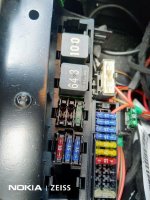
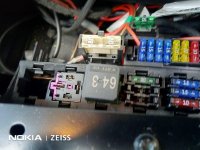
The one marked "100" looks like it is the VSR. I have starter battery voltage on one side and leisure battery voltage on the other. This is different to your layout @Loz as your pics show a separate bigger VSR.
So I think I could install the new Victron Orion TR Smart Non-Isolated DC to DC charger by hooking into these relay connections, and restore it back to factory spec just by replacing the relay.
Orion-Tr Smart DC-DC Charger Non-Isolated | Victron Energy
The Orion-Tr Smart DC-DC charger is a professional DC to DC adaptive 3-stage charger with built-in Bluetooth. For use in dual battery systems in vehicles or on boats where the alternator and the start battery are used to charge the service battery. The unit can be monitored and programmed via...
Is it possible to buy a relay "plug" that has the spade terminals mounted in a plastic moulding ready for soldering? Otherwise I'll rig up a plug with individual spade terminals and glue gun.
Does anyone know what the other relay marked 643 does? It energises when I plug in the EHU.


Mike Currie
Product Page | travelvolts
 www.travelvolts.net
www.travelvolts.net
You can buy a plug in relay with loads from the above.
rod_vw
Gone bigger.
Top Poster
VIP Member
The battery isolation relay is the one marked 100, it is not a voltage sensing relay, it is controlled by a signal from the Body Control Module (BCM) pin T73a/3 wire colour black and +ve signal.
Nominally when the BCM senses that the alternator is charging it energises the relay. I think this may also be influenced by load shedding parameters and release the relay if more essential current users are present.
This relay switches the charge current to either one or two leisure batteries depending on vehicle type, these are fused by independent fuses the one for the battery under the front seat is in fuse holder H by the battery and the other is near the battery in the furniture at the rear of the vehicle.
Nominally when the BCM senses that the alternator is charging it energises the relay. I think this may also be influenced by load shedding parameters and release the relay if more essential current users are present.
This relay switches the charge current to either one or two leisure batteries depending on vehicle type, these are fused by independent fuses the one for the battery under the front seat is in fuse holder H by the battery and the other is near the battery in the furniture at the rear of the vehicle.
A
a892374923874
VIP Member
Thank you. Yes, of course you are right, my bad wording.The battery isolation relay is the one marked 100, it is not a voltage sensing relay, it is controlled by a signal from the Body Control Module (BCM) pin T73a/3 wire colour black and +ve signal.
I've not tested that signal wire yet, is it an open collector type output? If so then I imagine it would hook into the "L" connector on the Victron, thus bringing the L terminal down to 0v when the alternator is charging, and enabling the DC DC charging on the Victron?
Similar threads
- Replies
- 6
- Views
- 2K
- Home
- Forums
- VW California T5 T6 & T6.1 Specific Sections
- VW California T5,T6 & T6.1 Specific Sections
- Electrical

About us
The VW California Club is the worlds largest resource for all owners and enthusiasts of VW California campervans.



